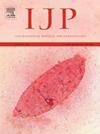What shapes a microbiome? Differences in bacterial communities associated with helminth-amphipod interactions
IF 3.7
2区 医学
Q1 PARASITOLOGY
引用次数: 0
Abstract
The fast technological advances of molecular tools have enabled us to uncover a new dimension hidden within parasites and their hosts: their microbiomes. Increasingly, parasitologists characterise host microbiome changes in the face of parasitic infections, revealing the potential of these microscopic fast-evolving entities to influence host-parasite interactions. However, most of the changes in host microbiomes seem to depend on the host and parasite species in question. Furthermore, we should understand the relative role of parasitic infections as microbiome modulators when compared with other microbiome-impacting factors (e.g., host size, age, sex). Here, we characterised the microbiome of a single intermediate host species infected by two parasites belonging to different phyla: the acanthocephalan Plagiorhynchus allisonae and a dilepidid cestode, both infecting Transorchestia serrulata amphipods collected simultaneously from the same locality. We used the v4 hypervariable region of the 16S rRNA prokaryotic gene to identify the hemolymph bacterial community of uninfected, acanthocephalan-infected, and cestode-infected amphipods, as well as the bacteria in the amphipods’ immediate environment and in the parasites infecting them. Our results show that parasitic infections were more strongly associated with differences in host bacterial community richness than amphipod size, presence of amphipod eggs in female amphipods, and even parasite load. Amphipods infected by acanthocephalans had the most divergent bacterial community, with a marked decrease in alpha diversity compared with cestode-infected and uninfected hosts. In accordance with the species-specific nature of microbiome changes in parasitic infections, we found unique microbial taxa associating with hosts infected by each parasite species, as well as taxa only shared between a parasite species and their infected hosts. However, there were some bacterial taxa detected in all parasitised amphipods (regardless of the parasite species), but not in uninfected amphipods or the environment. We propose that shared bacteria associated with all hosts parasitised by distantly related helminths may be important either in helping host defences or parasites’ success, and could thus interact with host-parasite evolution.

是什么塑造了微生物群落?与蠕虫-片脚类动物相互作用相关的细菌群落差异
分子工具技术的飞速发展使我们能够发现隐藏在寄生虫及其宿主体内的一个新维度:寄生虫微生物组。越来越多的寄生虫学家描述了寄生虫感染时宿主微生物组的变化,揭示了这些快速进化的微观实体影响宿主-寄生虫相互作用的潜力。然而,宿主微生物组的大多数变化似乎取决于宿主和寄生虫的种类。此外,与其他影响微生物组的因素(如宿主大小、年龄、性别)相比,我们应该了解寄生虫感染作为微生物组调节剂的相对作用。在这里,我们描述了被属于不同门类的两种寄生虫感染的单一中间宿主的微生物组特征:棘头蚤(Plagiorhynchus allisonae)和双尾蚤(dilepidid cestode),这两种寄生虫都感染了从同一地点同时采集的Transorchestia serrulata片脚类动物。我们利用 16S rRNA 原核基因的 v4 超变区鉴定了未感染、感染棘头蚴和感染绦虫的片脚类动物的血淋巴细菌群落,以及片脚类动物周围环境和感染片脚类动物的寄生虫中的细菌。我们的研究结果表明,寄生虫感染与寄主细菌群落丰富度的差异有更密切的关系,而与片脚类动物的大小、雌性片脚类动物体内片脚类动物卵的存在,甚至寄生虫量的差异都没有关系。被棘尾虫感染的片脚类动物的细菌群落差异最大,与绦虫感染和未感染的宿主相比,α多样性明显下降。根据寄生虫感染时微生物群落变化的物种特异性,我们发现了与每种寄生虫感染的宿主相关的独特微生物类群,以及仅在寄生虫物种和感染宿主之间共享的类群。然而,在所有被寄生的片脚类动物(无论寄生虫种类)中都检测到了一些细菌类群,但在未感染的片脚类动物或环境中却没有检测到。我们认为,与所有被远缘蠕虫寄生的宿主相关的共有细菌可能在帮助宿主防御或寄生虫成功寄生方面具有重要作用,因此可能与宿主-寄生虫的进化相互影响。
本文章由计算机程序翻译,如有差异,请以英文原文为准。
求助全文
约1分钟内获得全文
求助全文
来源期刊
CiteScore
8.40
自引率
2.50%
发文量
76
审稿时长
23 days
期刊介绍:
International Journal for Parasitology offers authors the option to sponsor nonsubscriber access to their articles on Elsevier electronic publishing platforms. For more information please view our Sponsored Articles page. The International Journal for Parasitology publishes the results of original research in all aspects of basic and applied parasitology, including all the fields covered by its Specialist Editors, and ranging from parasites and host-parasite relationships of intrinsic biological interest to those of social and economic importance in human and veterinary medicine and agriculture.

 求助内容:
求助内容: 应助结果提醒方式:
应助结果提醒方式:


